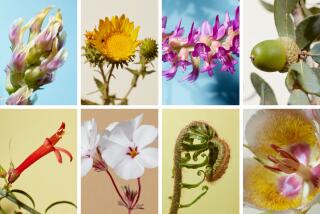Worth preserving
- Share via
LONG before Al Gore’s “An Inconvenient Truth,” there was activist-photographer Robert Glenn Ketchum’s prescient plea for preservation. Ketchum’s well-known imagery -- replicated in prints, posters and calendars -- has been intrinsically linked to the nation’s ecology movement for nearly four decades: rendering landscapes in their magnificent grandeur as well as hovering over the delicate particulars (the essential working parts). Before it was trendy, Ketchum’s eye had been trained on nature’s delicate balance and how it was being threatened -- deforestation, air and water pollution, endangered wildlife.
Recognized by Audubon magazine as one of the 100 champions of conservation of the 20th century, Ketchum hadn’t started on that path originally. Living in L.A., he did the L.A. thing and started out photographing musicians in their natural environment -- the Doors, Cream and Jimi Hendrix among them. But during his postgraduate studies at the California Institute of the Arts in the early ‘70s, he began to experiment both in style and subject matter -- moving from black and white to color, from the insular world of musicians to the expanse of the great outdoors. Not only did the content change, but the size of his prints as well. Ketchum and a friend, printer Michael Wilder, pioneered Cibachrome photography/cibachrome.html color printmaking and Ketchum became one of the first contemporary photographers to experiment with print scale -- rendering many of his sweeping expanses in sizes (many of the images are 24 by 30 inches but the largest ones are 48 by 65) that in some small way could replicate the magnificence.
Over the last few decades, Ketchum has traveled the globe to bring back evidence of nature’s vulnerable heartbeat. So it’s fitting that Venice’s G2 Gallery (billed as “an environmentally conscious art gallery” that donates all proceeds from art sales to environmental charities) will feature Ketchum’s work in a retrospective, “A Life Well Lived: 40 Years in the Making,” on view until Nov. 30. It showcases past and new work including his recent exploration of the Bristol Bay Salmon Fishery in southwestern Alaska.
-- Lynell George
More to Read
The biggest entertainment stories
Get our big stories about Hollywood, film, television, music, arts, culture and more right in your inbox as soon as they publish.
You may occasionally receive promotional content from the Los Angeles Times.










